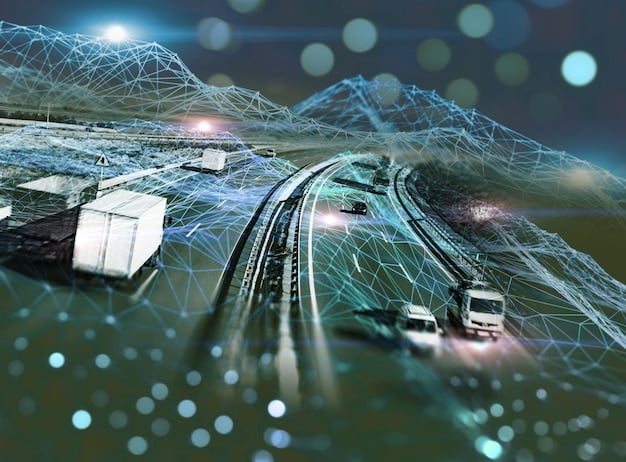AI for Sustainability: How US Businesses Can Cut Waste & Energy by 2026

US businesses can leverage artificial intelligence (AI) by 2026 to optimize energy consumption and reduce waste through smart grids, predictive maintenance, optimized supply chains, and waste management systems, leading to significant cost savings and environmental benefits.
How Can US Businesses Leverage AI to Optimize Energy Consumption and Reduce Waste by 2026? The answer lies in the transformative power of artificial intelligence. Businesses across the United States are increasingly recognizing AI’s potential to revolutionize operations, reduce environmental impact, and boost the bottom line. Let’s explore how US businesses can adopt AI to create a more sustainable future.
Understanding the Potential of AI in Energy and Waste Reduction
Across various sectors, AI presents numerous avenues for optimizing energy use and minimizing waste. Its ability to analyze vast datasets, predict patterns, and automate processes makes it a powerful tool for businesses aiming to enhance sustainability. From smart grids to predictive maintenance, AI can drive efficiency and reduce environmental impact.
Smart Grids and Energy Optimization
AI-powered smart grids can optimize energy distribution by predicting demand and adjusting supply accordingly. This reduces energy waste and ensures a more stable and efficient energy system.
Predictive Maintenance
AI algorithms can analyze data from sensors to predict when equipment is likely to fail, allowing for timely maintenance and preventing energy-intensive breakdowns.

Here are some key areas where AI can make a significant difference:
- Energy Management Systems: AI algorithms can monitor and control energy usage in buildings, adjusting heating, cooling, and lighting based on occupancy and environmental conditions.
- Renewable Energy Integration: AI can optimize the integration of renewable energy sources into the grid, ensuring a consistent and reliable energy supply.
- Waste Sorting and Recycling: AI-powered robots can efficiently sort waste materials, increasing recycling rates and reducing landfill waste.
By implementing these AI solutions, US businesses can significantly reduce their energy consumption and waste generation, contributing to a more sustainable and environmentally friendly operation.
Implementing AI-Driven Energy Management Systems
One of the most promising applications of AI is in energy management systems. These systems use AI algorithms to monitor and control energy usage in buildings and industrial facilities, adjusting energy consumption based on real-time data and predictive analytics. Businesses can achieve substantial energy savings and reduce their carbon footprint by implementing AI-driven energy management systems.
Benefits of AI-Driven Energy Management
AI-driven energy management systems offer numerous benefits, including reduced energy costs, improved energy efficiency, and enhanced sustainability.
Challenges in Implementation
Despite the benefits, implementing AI-driven energy management systems can be challenging. It requires a significant investment in data collection, infrastructure, and expertise.
To successfully implement AI-driven energy management systems, businesses should consider the following:
- Data Collection: Gather comprehensive data on energy usage patterns, occupancy, and environmental conditions.
- Infrastructure: Invest in sensors, smart meters, and other devices that can provide real-time data.
- Expertise: Partner with AI experts or hire data scientists who can develop and implement AI algorithms.
Proper planning and execution can overcome these challenges and unlock the full potential of AI-driven energy management.
Optimizing Supply Chains with AI for Waste Reduction
AI can also play a crucial role in optimizing supply chains to reduce waste. By analyzing data on demand, inventory, and logistics, AI algorithms can identify inefficiencies and opportunities for improvement. This results in reduced waste, lower costs, and a more sustainable supply chain.
Demand Forecasting
AI can accurately forecast demand, allowing businesses to optimize production and reduce excess inventory that often leads to waste.
Logistics Optimization
AI can optimize transportation routes and delivery schedules, reducing fuel consumption and emissions.

Consider these strategies to optimize supply chains using AI:
- Predictive Maintenance: Use AI to predict equipment failures in the supply chain, reducing downtime and waste.
- Inventory Management: Implement AI-driven inventory management systems to optimize stock levels and reduce spoilage.
- Sustainable Sourcing: Use AI to identify and prioritize suppliers who adhere to sustainable practices.
By leveraging AI, businesses can create more efficient and sustainable supply chains, reducing waste and minimizing their environmental impact. This can lead to lower costs and a stronger brand reputation, as more consumers are becoming environmentally conscious.
AI-Powered Waste Management and Recycling
Traditional waste management processes are often inefficient and labor-intensive. AI can automate many of these processes, making waste management more efficient and cost-effective. AI-powered robots can sort waste materials with greater accuracy and speed than humans, increasing recycling rates and reducing landfill waste.
Robotic Waste Sorting
AI-powered robots can identify and sort different types of waste materials, such as plastics, paper, and metals, with high precision.
Smart Waste Bins
Smart waste bins can use sensors to monitor fill levels and optimize collection routes, reducing fuel consumption and emissions.
Here are some ways AI can transform waste management and recycling:
- Automated Sorting: Implement AI-powered robotic sorting systems in recycling facilities.
- Waste Tracking: Use AI to track the movement of waste materials from collection to processing, ensuring accountability and transparency.
- Data Analysis: Analyze waste data to identify trends and opportunities for reducing waste generation.
These AI solutions not only improve the efficiency of waste management but also contribute to a more circular economy by maximizing the reuse and recycling of materials.
Overcoming Challenges and Ensuring Successful AI Integration
While AI offers tremendous potential for optimizing energy consumption and reducing waste, integrating AI solutions into existing business operations can be challenging. Addressing these challenges is crucial for ensuring successful AI integration and realizing the full benefits of AI.
Data Privacy and Security
AI systems require access to large amounts of data, which raises concerns about data privacy and security. Businesses must implement robust data protection measures to prevent breaches and ensure compliance with regulations.
Lack of Expertise
Implementing AI solutions requires specialized expertise in data science, machine learning, and software engineering. Businesses may need to hire new staff or partner with AI consulting firms to overcome this challenge.
Consider these strategies to overcome these challenges:
- Data Governance: Implement a data governance framework that ensures data quality, security, and privacy.
- Training and Development: Invest in training and development programs to build AI expertise within your organization.
- Strategic Partnerships: Collaborate with AI vendors, research institutions, and industry peers to share knowledge and best practices.
By addressing these challenges proactively, businesses can ensure a smooth and successful AI integration process and maximize the impact of AI on energy consumption and waste reduction efforts.
Measuring and Reporting the Impact of AI on Sustainability
Measuring and reporting the impact of AI on sustainability is essential for demonstrating the value of AI investments and tracking progress towards sustainability goals. Businesses should establish clear metrics and reporting mechanisms to monitor the performance of AI-driven energy and waste reduction initiatives.
Key Performance Indicators (KPIs)
Establish KPIs to measure the impact of AI on energy consumption, waste generation, and recycling rates.
Reporting Mechanisms
Implement reporting mechanisms to track and communicate the performance of AI-driven sustainability initiatives to stakeholders.
Effective measurement and reporting practices include:
- Energy Consumption: Track energy usage before and after implementing AI-driven energy management systems.
- Waste Generation: Monitor waste generation rates and recycling rates to assess the impact of AI-powered waste management solutions.
- Carbon Footprint: Calculate the carbon footprint of your operations and track reductions achieved through AI initiatives.
Regularly reporting on these metrics will help businesses demonstrate their commitment to sustainability and attract environmentally conscious customers and investors.
| Key Point | Brief Description |
|---|---|
| 💡 AI-Driven Energy Management | Optimizes energy use in buildings by adjusting consumption based on real-time data. |
| 📦 AI-Optimized Supply Chains | Reduces waste by improving demand forecasting and logistics, ensuring efficient operations. |
| ♻️ AI-Powered Waste Management | Automates waste sorting with robots, increasing recycling rates and reducing landfill waste. |
| 📊 Measuring Impact | Tracking KPIs like energy consumption and waste reduction to demonstrate the value of AI. |
Frequently Asked Questions
▼
AI can monitor and control energy usage in buildings, adjusting heating, cooling, and lighting based on occupancy, weather conditions, and other factors, optimizing energy use.
▼
AI analyzes demand, inventory, and logistics data to identify inefficiencies, enabling businesses to optimize production and reduce excess inventory, minimizing waste.
▼
AI-powered robots automatically sort waste materials, increasing recycling rates and reducing landfill waste. Smart waste bins monitor fill levels to optimize collection routes.
▼
Challenges include data privacy and security concerns, the need for specialized expertise, and the initial investment in data collection and infrastructure setup.
▼
Businesses can track key performance indicators (KPIs) such as energy consumption, waste generation rates, recycling rates, and the overall carbon footprint reduction.
Conclusion
As US businesses look to optimize energy consumption and reduce waste by 2026, AI stands out as a transformative technology. Embracing AI-driven solutions can lead to significant cost savings, environmental benefits, and a more sustainable future. By addressing challenges proactively and measuring the impact of AI initiatives, businesses can unlock the full potential of AI and drive meaningful progress toward a greener and more efficient economy.

